ALLEN COUNTY LEADERS
ALLEN COUNTY LEADERS
These individuals are recognized for their leadership in improving daily life in Allen County, inspiring its people, and shaping the county into what we know it as today.

Altstaetter Family
The Altstaetter family, known for their musical talents, became a household name in Allen County during the 20th century.
Altstaetter Family
The Altstaetter family, known for their musical talents, became a household name in Allen County during the 20th century. The Altstaetter Band was a large group of self-taught musicians talented on a variety of instruments for both traditional band and orchestra arrangements. They traveled to events across the community from World War I through the 1930s. The newspapers highlight their reach as a band and immense talents throughout their career, with articles and titles specifying that they played for a community picnic of 4,000 in 1917, led the march of 1,000 for a new church dedication in 1915, and delivered free concerts attended by many at their family home. The family consisted of Jacob and Emma and their children: Emil, Gilbert, Clifford, Marie, Waldo, Albert, Clara, Lena, Lewis, Clarence, Alice, and Harold. Alice and Harold were not able to participate in the band at its start due to their young ages. Jacob’s father, also named Jacob, immigrated from Germany in 1832, eventually traveling to Allen County, where he purchased 40 acres of land near present-day Columbus Grove. Jacob would inherit and expand the farm to 160 acres, and there he raised his children. He was always interested in music, having been known as a child to practice for hours in the barn on his instruments. He passed that love on to his children, who learned 17 instruments including variations of the cornet, clarinet, trombone, snare drum, violin, piano, horn, mellophone, and harp. Several of the Altstaetter children played multiple instruments for their variety of concerts. The family band was distinctly outfitted in complete uniforms. Their winter outfits were blue with black trim, and their summer uniforms were all white. Their uniforms and musical instruments are on display at the Allen County Museum.
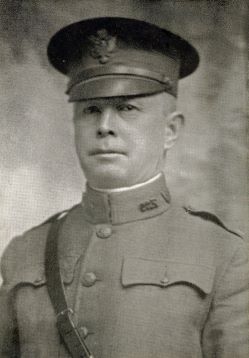
Dr. John H. Blattenberg
1869-1924
A renowned veterinarian, World War I veteran, and an active citizen of Allen County.
Dr. John H. Blattenberg
Dr. John Horace (J.H.) Blattenberg was a renowned veterinarian, World War I veteran, and an active citizen of Allen County. He was born on May 2, 1869, in Smithville, Ohio. Blattenberg earned a doctorate from the Ontario Veterinary College in Toronto, Canada, in 1892 at the age of 23. After briefly working in Toledo, Ohio, he set up a clinic in an old streetcar barn on Spring Street in Lima. Blattenberg specialized in the care of horses, owning and racing several of his own. In 1912, he invented the “Ventrical Burr,” a device that simplified the surgery that was used to cure laryngeal hemiplegia- an equine respiratory condition. His veterinary skills were renowned nationwide, causing him to garner significant praise and presentations at prestigious veterinary conferences. Because of this, Blattenberg was elected president of the Ohio Veterinary Association in 1903.
In March of 1916, prior to the United States’ involvement in World War I, Dr. Blattenberg traveled to the battlefields of Europe as a correspondent for the American Journal of Veterinary Medicine. Upon his return home, he became a proponent of the preparedness movement in Lima. This movement sought to prepare residents for the nation’s impending entry into the conflict. In December 1917, he helped organize a Red Star Animal Relief Society branch in Allen County to supply horses for the war effort. Later that month, at the request of government officials, he was commissioned as a major with the Veterinary Corps of the American Expeditionary Force and returned to the front. Blattenberg remained connected to Lima throughout his service by sending letters home. Following World War I, Blattenberg returned to Lima and resumed his veterinary practice. Many of the items he brought back from the front are in the Allen County Historical Society Collection.
Additionally, Dr. Blattenberg was a very active member of this community. He belonged to many organizations and societies, including the Knights of Pythias, Rotary Club, Sons of the American Revolution, American Legion, and Free Masons. He acted as Marshal during several parades in Lima, was a commissioner, and later a Trustee, for the Fort Amanda Memorial Commission and represented Lima in the 1917 Allen County Memorial Celebrations.
On November 13, 1924, Dr. Blattenberg suffered a Cerebral Hemorrhage while attending to a sick horse. He was remembered for his “jocular disposition, ready wit, and wholesome philosophy.” Several physical reminders of Dr. Blattenberg persisted in Lima, such as the V.F.W Post 1275, named in his honor, and the Blattenberg Block, which existed from 1904-2020.

Joseph C. Bradfield
1889-1936
Esteemed community doctor, social activist, and namesake behind the Bradfield Community Center
Joseph C. Bradfield
Dr. Joseph C. Bradfield, an esteemed doctor with a career spanning over 25 years, worked towards benefiting the Black community through healthcare, social-welfare programs, and politics. He was born in 1889 in Mount Vernon, Ohio. He attended the Starling Medical College in Columbus, Ohio, which later transformed into the Ohio State University College of Medicine, and he graduated in 1911. In 1912, Bradfield and his wife, Edith Payne, moved to Lima. Joseph Bradfield served during World War I in the Army Medical Reserve Corps. He worked at the 365th company field hospital in France. Bradfield set up his medical practice here in Lima when there were fewer than 750 Black residents. That number would grow following the Great Migration of Black workers from the South to the North, the Midwest, and Western industries for greater opportunity. Bradfield worked to create better living and working conditions for the community by updating their sanitation and serving as an experienced doctor for the health of the residents. Bradfield was active in a multitude of organizations, such as the local chapter of the National Association for the Advancement of Colored People (NAACP), the Endocrine Club, and the Lima and Allen County Academy of Medicine, to name a few. He strongly believed that participating in politics was the answer to many of the ills of the Black community. He was described as “partisan [Republican] to the core.” As a part of his work in creating social-welfare programs, Bradfield and a number of other committee members started the Citizen’s Recreation Center in 1933. The doctor passed away in 1936 after catching pneumonia at the age of 47. The Citizen’s Recreation Center was renamed the Bradfield Center in 1938 to honor the doctor who dedicated his life to the Lima community.

Bessie Crayton
1857-1933
Leading suffragette, temperance advocate, and President of the League of Women Voters
Bessie Crayton
Bessie Crayton, born Mary Elizabeth Catt in 1857, was a leading Suffragist and supporter of Prohibition in the community. Social activism was prevalent in her family as she was related to Carrie Chapman Catt, who was a leading national campaigner for Women’s Suffrage during the same time period. Crayton was the president of the Political Equality Club, which later transformed into the League of Women Voters. Prior to her marriage in 1881 and the birth of her son, Guy, Bessie was a school teacher. Crayton believed that the Temperance and Suffrage movements were allied efforts, and so she devoted herself to both. She pushed for Prohibition through her involvement in the Women’s Christian Union and was the backbone behind the local Suffrage movement. She was described as being one of the only women who identified with the Suffrage movement in Allen County. Her husband, William, was an equal supporter of women’s Suffrage and her work in various organizations. Crayton and her husband spread the message of Temperance and enrolled over 200 children in the Loyal Temperance Legion on the South Side by 1921. In nineteen-fourteen, Bessie co-organized over 1,500 marchers for a Suffrage parade through the city square. The Political Equality Club campaigned throughout Lima and passed out pamphlets to spread awareness of women’s right to vote. Finally, their dream was recognized in 1919 when Ohio passed the Suffrage bill granting the right to vote, and the following day, the 19th Amendment was ratified. When the organization was transformed into the League of Women Voters, Bessie led classes on how to register and vote in elections, providing valuable education to first-time women voters. Crayton and the rest of the Suffragists are remembered for their contributions and dedication to women receiving the right to vote in Ohio in 1919. In twenty-twenty, 100 years after the 19th Amendment became law in the United States, a plaque was placed in the city square commemorating Bessie and the Allen County Political Equality Club’s contributions towards Suffrage. To learn more about Bessie and other area women’s roles in Allen County’s fight for Suffrage, visit the Campaigning for Votes: Women’s Suffrage in Allen County online exhibit.

Emmaline Maud Crockett
1868-1955
First Registered Nurse in Allen County
Emmaline Maud Crockett
Emmaline Crockett was the first registered nurse in Allen County. Crockett spearheaded the development of a hospital and cleanliness standards during surgery. She was born on August 15, 1868, in Greenville, Ohio. Emmaline Maud Stines began her career as a nurse in Cincinnati. She attended school at Maple View Hospital, which was led by Dr. Charles A. L. Reed. While training, a patient from Columbus Grove recommended, due to her quality work, that she would be an asset to Lima. Like many other cities in the late 1800s and early 1900s, Lima lacked a hospital. If a problem plagued a patient, they would find the office and get treatment there, or the physician would be called to the patient’s place of residence. Crockett sought to create a hospital in Lima as the need for them was gaining traction across the country. The field of “modern” medicine, however, was still continuing to grow. Emmaline stated that it was hard to adjust to the rural surroundings and crude implements. She introduced the idea of tool sterilization and overall cleanliness to physicians during surgeries.
Crockett, when she first arrived, encountered rejection and fear from all positions about the idea of the creation of a hospital. Physicians when she arrived were not agreeable to the idea of working together, and the citizens had a poor opinion of hospitals. Some stated that they considered them to be butcher shops or places for experimentation. However, the number of nurses and doctors needing to travel across the community was not substantial enough to support the patients. A hospital would be created beginning in 1898, with the final placement and grand opening the following year.
Emmaline left nursing following her marriage to Charles H. Crockett, of Lima, on October 29, 1896. They had one son named Charles Crockett Jr. She continued to be active in a variety of community organizations. She was an early member of Lima Choral Society, Christ Church, the Allen County Historical Society, and a charter member of the Buckeye State Button Society. Crockett was also a member of the Daughters of the American Revolution (DAR) and was highly interested in birds. While working as a fifth-grade room mother at Franklin Elementary, she formed a bird-feeding club in the 1920s. The club members were to feed the birds whenever snow or ice covered the ground. The members were distinguishable by a white string in their buttonholes. During World War II, Emmaline was the known story keeper of local history. She created scrapbooks of engagement and wedding announcements from the Lima News for all of the young men and women in the community.

William Kennedy Davenport
1915-1999
The First Black Police Chief of Lima
William Kennedy Davenport
An admired leader in Allen County, William Kennedy Davenport served with the Lima Police Department (LPD) for over 36 years. Davenport was born on February 24, 1915, in Green Castle, Pennsylvania; however, he would move to Lima at a young age. He was the Chief of Police for 10 years, from 1968 to 1978, where he had the difficult task of uniting Lima. Davenport earned the job after receiving the best scores in the department on the civil service exam thus bypassing the need for appointment by mayor or city council. Davenport is described as being an inspiration to the black community by the Lima News, saying that regardless of background, success is possible.
As Chief of Police, he strived to create a real sense of community within the city’s diverse population. The 1970s were a time of racial uproar and civil unrest across the United States, and Lima was no exception. Davenport is credited with decreasing the tensions of the era in the city. Even within his department, he was striving to be reflective of the community. He hired the first woman police officer, Barbara Kristine Latham, in LPD’s history.
Davenport never sacrificed his principles while leading the community, even when they were challenged. He refused to back down from a conflict with Mayor Morris when he decided to pull out police officers from Lima’s south end, where there was a large Black Panther presence. Davenport wanted to prove that he was not harassing the group, but the mayor was frustrated, believing that he should have been consulted before the decision was made. He turned in his resignation over the ordeal; however, the mayor refused to accept his decision, and the two settled their differences.
He felt that being a policeman was more than putting people in jail. Bettering the community far outweighed the enforcement of the law. Davenport recognized the power the youth held, and he challenged these communities to bridge the gap between white and black America. Davenport constantly worked to improve relations between the Lima Police Department and its residents
After his time at the LPD, he would continue to be an active and cherished member of Allen County. Davenport was the president of various organizations across the city and was even the grand marshal for the Lima Labor Day Parade in 1986. In 1999, He passed away in his Lima home at the age of 84, leaving behind a long legacy of civil service that can still be felt across Lima today.
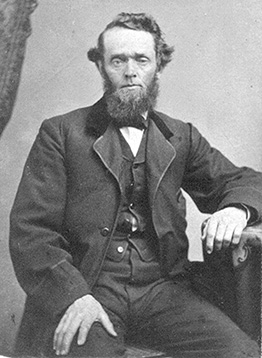
Benjamin Faurot
1829-1904
Discovered oil in Lima, brought electricity to the city and supported the arts and community
Benjamin C. Faurot
Benjamin Faurot, known as B. C. Faurot, made Lima known for industry and the arts. Educated for only one year, he worked as a farmhand for his father and later as a teamster hauling gravel in Kenton. In the 1850s Faurot followed Pennsylvania Railroad’s arrival to Lima, where his livery business supplied horses and mules to the Union during the Civil War. Faurot married Helen Wells in 1853, and they had three daughters. He was a staunch Republican and belonged to Trinity Methodist Church, serving on its financial committee. Faurot expanded his fortune through investing in Lima’s real estate and incorporated what became Lima National Bank in 1865. He served as president and navigated the business through the Panic of 1873. In 1870 he organized and became president of the Lima Paper Mills, one of Lima’s largest employers. Faurot was also president of the American Strawboard Association. Following Faurot’s team discovery of oil at the mill on May 9, 1885, Lima’s industry and population grew. That same year, Faurot built Lima’s first electric plant. He organized the electric lighting of Lima’s streets, making Lima, Ohio’s third city to electrify. After acquiring the horse-drawn Lima Street Railway in 1878, he electrified the service by 1887, which became one of the first electric railways in the country. He and Calvin Brice worked to bring the Erie Railroad (later Nickel Plate) repair shop to Lima. Faurot organized and acted as President of the Globe Machine Works, Inc. that manufactured portable engines. He also supervised a canning operation for sweet corn on his 700-acre farm. Community-minded Faurot planned a parks system. He opened a park and a driving park on his farm. There the community enjoyed horse races, plays, and baseball games. He built the Faurot Hotel and Faurot Block in 1882. The Faurot Block housed the Faurot Opera House, where international talent performed, and a music hall. The Lima National Bank failed in 1892 after Faurot overextended his finances following the sale of the Lima Paper Mill. He sold the mill to invest in what would become the Lima-Defiance Railroad (completed 1899) and in plans to colonize Mexican land for a Mormon colony and railroad. Within the next 10 years, Faurot lost his wife, daughter, son-in-law, three grandsons, all of his businesses, the Faurot Block, his farm, and West Market Street home. Lima’s generous benefactor died destitute and was buried in Woodlawn, a cemetery he helped plan.

Joyce Garrett
1926-2011
The first black teacher in the Lima community in 1953
Joyce Garrett
Joyce Jones Garrett was incredibly involved in the community throughout her entire life and career here in Allen County. Garrett was born on July 12, 1926. At the time, her father was a chauffeur for a wealthy family in Lima. They lived just above the garage in a small apartment split between her parents, Mabel and Leroy, and her brother Thomas. She attended Roosevelt Elementary and later graduated from Central High School in 1944. Garrett attended the historically black college, Central State University in Wilberforce, Ohio. She received her bachelor’s degree with honors in 1948. Following graduation, Joyce moved to Madison, Illinois to pursue teaching. There she met her husband Forrest Garrett, and they had one son named Forrest Craig Garrett. Joyce and her husband Forrest would divorce after a short time of marriage. She later returned to Lima, and she took on positions across the schools in the community as a substitute teacher as that was the only position people of color could work. It took pressure from groups on both sides of the segregation issue for the school to take a stance and offer Garrett a position as the first black teacher in the community in 1953. For the next several years, she taught sixth grade at Irving and Horace Mann Elementary. Joyce returned to school to further advance her education and she graduated from Case Western Reserve University in Spanish in 1967. She continued her studies in Spanish in Mexico at The Academia International de Español in Saltillo, Mexico.
In 1959, WIMA-TV with community funding created a program to broadcast Spanish, educate the public, and have it be used as a tool in classrooms across Allen County. Joyce, and fellow Central State University Alumnae, Rose Jefferson, led the program from 1959-1964. In 1966, she began teaching Spanish at Lima Senior High School. She was chairwoman of the foreign language department for the city schools from 1974-1984. She retired after 31 years of teaching, 35 years total. That was not the end for her, however, she continued to educate and be a leader throughout the community. She was heavily awarded for her teaching, earning several awards throughout her career. Garrett was a charter member and later president of the Help yourself, Help others Club (HYHO) here in Lima. She taught Spanish for 24 years after her retirement to preschoolers, effectively teaching them to read and speak in Spanish at the Learning to Learn with Care School. Joyce was a lifelong member of the Alpha Kappa Alpha Sorority, which following her passing set up several community scholarships and funds in her name. She was also a member of the Delta Kappa Gamma International society, National Association for the Advancement of Colored People (NAACP), the Allen County Retired Teachers Association, a member of the YWCA board and she served as a board member for several years with the Allen County Historical Society. She passed on July 26, 2011 at 85 years of age. She is buried in Woodlawn Cemetery.

Dr. Anna Mary Goebel
1849-1914
Doctor specializing in the diseases of women and children and nervous diseases
Anna Mary Goebel
Anna Mary Goebel was born in Carlisle, Pennsylvania, on May 20, 1849 to John and Mary Boarst Goebel, immigrants from Bavaria, Germany. Her family came to Lima in the 1850s. She and her four brothers attended Lima Public Schools. After graduation in 1862, Goebel turned to the study of medicine. She furthered her education at the Ursaline Convent in Toledo, Ohio, for one year and at the Female Medical Collage in Philadelphia, Pennsylvania, for two years. Goebel then moved to Michigan, where she worked in the Detroit hospitals for one year. She graduated second in her class of eighty students after completing a three-year course at the College of Medicine, University of Michigan in Ann Arbor. After completing her education, she returned to Lima. By 1888, Dr. Goebel operated her practice out of her home at 762 W. North St. She had many clients, and she opened an office at 45 ½ Public Square by 1907. Dr. Goebel specialized in the diseases of women and children and nervous diseases. From caring for community members to family members, Dr. Goebel dedicated herself to medicine. She cared for her mother, who suffered from paralysis and died in 1898, and her brother Phillip, a Lima Police Officer who was shot and died in 1902. Dr. Goebel was also active in the local community. In 1888, she participated in the Woman’s Allen County Centennial Association, which was organized to commemorate the centennial of the Northwest Territory, where she led efforts to highlight literature covering professions. Her personal library consisted of texts on a variety of topics, such as a 34-volume set of the novels of Balzac, which were ultimately donated by George Lisle Parmenter to the Lima Public Library eleven years after her death. Dr. Goebel was installed as Assistant Guard of the Women’s Relief Corps in 1889. She suffered from a spinal injury or disease starting around 1907, causing her health to begin to decline. When her health degraded rapidly in 1913, she had to retire from her practice of over 25 years. Despite seeking treatment in France, Florida, and Indiana, Dr. Goebel ultimately passed away in Washington, D.C. at the home of her brother, Joseph. She bequeathed $150, or around $4,500 today, to Mt. Angel, a Benedictine Monastery in Oregon, and half of the profits from the sale of her Tennessee land were given to the Catholic Church Extension Society. Dr. Goebel is buried in Gethsemani Cemetery in Lima.
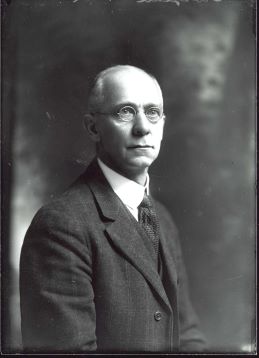
James Eugene (J.E.) Grosjean
1861-1938
A widely known industrialist, inventor, and leader of various businesses in Allen County.
J. E. Grosjean
James Eugene (J.E.) Grosjean was a widely known industrialist, inventor, and leader of various businesses in the community. He was born in 1861 in Wayne County, Ohio. Prior to 1892, Grosjean worked as an undertaker at Grosjean & Engel in Holmes County, Ohio. After 1892, he moved to Lima and took over the undertaking business of J.C. Musser in the Southwest corner of the Public Square (No. 17), purchased a white funeral coach and employed several other undertakers. However, the funeral business was not his only career. He began the J.E. Grosjean Shoe Store in the Public Square in 1902. He also pioneered the rubber heels and soles for shoes after seeing how someone had mended a worn shoe sole with a piece of tire. The newfound company in 1920 was known as Lima Cord Sole and Heel Company. The factory that produce the soles was located on North Elizabeth Street. In 1924, the business expanded and moved to 817 North Jackson Street. Grosjean stepped down as president in 1937and gave the reigns of the business to his son-in-law (husband of Pearl), Frank Maire. The name was changed in 1945 to GroCord Rubber Company. Another business venture included the Humane Horseshoe Company, which was named after the Humane Horseshoe he invented. It began in 1906 and it factory was located three acres south of the Detroit Southern and Bellefontaine Avenue Station.
Grosjean held 16 patents for a variety of items and improvements. Including, The Cock Robin Machine, Brake Lining Improvements, A Pall Bearer Arm Band, New Sole Thread Designs, Vulcanized Soles, a Non-Slip Bathmat, and the Humane Horseshoe.
His shoe store in the Public Square highlighted his extravagant technical miniatures and were a popular attraction. In 1893, Grosjean visited the World’s Fair in Chicago. Some of his most notable works include a Ferris Wheel with birds and animals, the wheel was created by John Carnes of Lima Locomotive Works, The Story of Cock Robin (Loaned and later lost in the 1913 flood in Dayton, Ohio), Noah’s Ark, and Albino & Extinct Animals. Following the move of his undertaking business to the Boone Block in 1894, he displayed taxidermy in the windows. These works traveled across the country and were shown in notable locations like the Marshall Fields in Chicago and Macy’s in New York. Later, Grosjean held his own exposition of his work near Niagara Falls, but it was not as successful. All of the remaining displays are at the Allen County Museum.
J.E. Grosjean was heavily involved in several organizations and took on leadership roles. Among these are his delegate position to the National Funeral Director Convention at Omaha in 1898, on the legislative committee of Ohio Funeral Directors Association in re-licensing in 1900, and the President of the board of the Allen County Historical Society from 1915-1938.
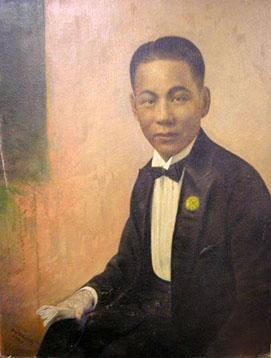
Jack Inoway
1889-1942
Area restaurateur, vaudeville performer and dedicated community member
Jack Inoway
The talented chef and business owner, Jack Inoway, was a huge contributor to the Lima community in his life. Jack was born in Japan around 1889. Inoway, originally spelled Inoue, immigrated to the United States at the turn of the century. He married Toshi Hujii, and they had two children named Katie and Carl. Inoway had an incredible career. He began on the Vaudeville stage, showcasing his talent for entertainment and his inverted- and reversible-writing tricks, which were widely recognized. After a short time in the group, Jack enlisted in the Navy, where he honed his cooking skills and he participated in the Navy’s World Cruise from 1907 to 1909. Inoway is remembered for being a well-known cook who opened a variety of restaurants during his life in Lima, including Jack & Yoshi Cafeteria, Jack’s Cafeteria, and Jack and Frank’s Steak House. Jack purchased 80 Japanese Cherry Blossom trees for $500 that were planted around Schoonover Lake in the park in 1938. He purchased them as “a living memorial to his two children as well as an act of appreciation to the city in which he said he has great faith in the future.” Although the trees are no longer there, a plaque stands memorializing Jack Inoway’s contributions to the community. However, loved as he was in the community, he was not immune to what was happening outside of Lima. Nineteen forty-one brought the bombing of Pearl Harbor and the fear of Japanese-Americans. Jack’s business was searched for ties to the enemy, Japan. He was subsequently cleared, but he decided to no longer pursue cooking. He sold his share of the business to his partner, Fred C. Harrison. Before his death, Inoway had dreams of re-enlisting to support the United States during World War II. However, he passed away before he was able to do so, and like many other Japanese-Americans, Inoway’s family was sent to an internment camp in the western United States. His family visited Lima many years later.
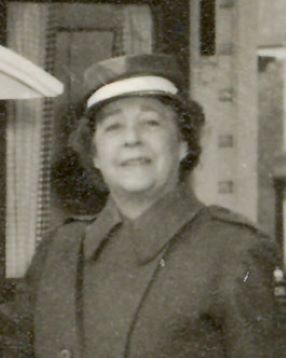
Ellouise Baker Larsen
1877-1967
Supervisor of Lima Servicemen Canteen & Foremost Scholar on Staffordshire China
Ellouise Baker Larsen
Ellouise Baker Larsen was born in Dennis Port, Massachusetts, on July 14, 1877 to Samuel S. and Julie Baker. In 1906 she married Lima financier and industrialist, Lewis A. Larsen, he was the vice-president and treasurer of the Lima Locomotive Works and later founder of Superior Coach CO. By profession, Baker was a writer and teacher. Early on in life, she served the Lima community as a public school teacher. However, she would find her true calling in the early 1920’s when she began studying and writing about Staffordshire China, a type of English china that features American scenes. The beautifully crafted china was created in order to mend relations between the United States and Great Britain after the War of 1812. Baker was an avid collector, making a name for herself as the world’s foremost authority on Staffordshire china. She wrote what’s considered to be the most definitive work on the subject: “American Historical Views on Staffordshire China.” Still, it is her leadership and involvement at the local canteen during World War II that would put Lima on the map. In October of 1942, the canteen was built in 16 days, beginning operations shortly after. From 10 a.m. until 10 p.m. for seven days a week volunteers would help between 750-800 soldiers daily at the junction of the Pennsylvania and Baltimore & Ohio railroads. Under the leadership of Baker, and with the support of the community, the canteen served 1,621 men in its first week of operation. Over 400 Lima businesses and residents rallied behind the canteen donating money, cooking supplies, and magazines. Due to the community’s support, the Lima canteen served as a morale-boosting, memorable experience for soldiers from across the globe. Uniformed men and women always remembered the warm hospitality felt by the local volunteers, often writing letters to thank them for their generous deeds. Ellouise made it a priority to answer every letter that the canteen received throughout its existence. Soldier’s comfort and relaxation was at the forefront of her mind, especially during the holidays. Every Thanksgiving and Christmas, Baker was determined that every serviceman passing through Lima would get a piece of turkey. Beyond serving food, the canteen assembled “buddy bags” containing toiletries for wounded soldiers. With the guidance of Baker, the canteen flourished into a large-scale operation serving over 650,000 men and women in uniform even after the war. Once the canteen closed, Baker continued to collect and lecture on Staffordshire China until her husband’s death in 1957. Following Lewis Larsen’s passing, Baker donated part of her collection to the Smithsonian as well as the Allen County Museum where it remains today. She peacefully lived out her days at her house on West Market Street until her passing in 1967.

James Mackenzie
1814-1901
Soldier, lawyer, political activist, teacher, newspaper editor, and judge
James Mackenzie
The Honorable James Mackenzie had a wide-ranging career of being a soldier, a lawyer, political activist, teacher, newspaper editor, and judge. He was born in Alythe, Scotland, in 1814. James’ father William Mackenzie owned a newspaper in Canada, and that was where James learned the business. Mackenzie moved to Ohio in 1837 as the Canadian Rebellion was rising, and he left to support the effort. Mackenzie was unsuccessful in his attempts and returned to the United States. He immediately went to work in New York for a newspaper called the Freeman’s Advocate, which supported the Canadian freedom cause. During Mackenzie’s time in Rockport, New York, he began to study law. He continued those studies in Cleveland, Ohio, and he passed the bar in 1839. James worked as a teacher and a school examiner across Ohio. Mackenzie moved several times in the next few years and worked as a prosecuting attorney in Henry, Putnam, and finally Allen County. He was elected in 1853 as the representative from Putnam and Henry Counties to the Ohio State Legislature. While in Putnam County, James published The Kalida Venture for 10 years. After working on that, he moved to Allen County in 1858, and worked as a prosecuting attorney, and published The Allen County Democrat for two and a half years. By 1863, he was elected as judge of the Common Pleas Court, which is a position he held until his retirement in 1898.
On May 28, 1846 Mackenzie married Lucina P. Leonard. Their octagonal home is described as being large with a complete library, which acted as the first public library for the citizens of Allen County. The house no longer stands and instead is now the site of Huntington Bank. They had seven children with six of them surviving to adulthood. Their surviving children were Ella G., Eugene C., William L., Mabel, Isabella, and Lucina Augusta (Finch). His children were equally ambitious in their own careers, whether legal or business-related here in Allen County. All of the daughters were heavily involved in the Allen County Historical Society and the Philomathean Club. He lived out the remainder of his years with his unmarried daughters in their home at 227 S. Collett Street, where they moved after Lucina died in 1888.

Dorothy Bernice “Bernie” Montague
1915-2022
The first woman in Allen County to hold an elected county-wide office
Bernie Montague
Bernie Montague became the first woman to hold an elected county-wide office through dedication and hard work. She started working in the County Recorder’s Office in 1934, working her way up to Chief Deputy Recorder in 1948. The Recorder’s Office kept real estate records from Allen County, such as deeds, mortgages, easements, leases, plats, federal and personal tax liens, corporation liens, mortgage cancellations and financial statements on chattels. The office also held records of military discharges and unemployment compensation. Under her predecessor, Morgan N. Davis, the first microfilming and photographic duplication of records began. When the recorder died in office in August of 1963, Montague was appointed interim recorder. In the 15 days that the GOP had to decide who would finish the term, she applied for county recorder and campaigned for the position. Bernie announced publicly that she was seeking that position, and she successfully lobbied for it through calling or meeting with every committee member. In an interview with The Lima News, GOP Chairman Kent McGough said the decision was “above politics,” because Montague was “the most qualified person” for the county recorder opening. Her friendly and straightforward demeanor along with her experience inspired both parties to support her, according to The Lima Citizen. Montague was a member of the Allen County Republican Party. She ran successful campaigns for County Recorder, serving four consecutive terms and a total of seventeen years until her retirement in 1980.
James and Grace Montague raised Bernie in Elida. The family moved to Lima following her father’s death. She enjoyed cooking, playing the violin in the Lima Symphony Orchestra, and traveling.
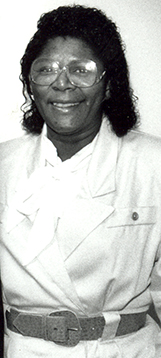
Frances Napier
1942-2016
5th Ward representative on the Lima City Council for over ten years
Frances Napier
An active community member, Frances Napier believed “every citizen has a civic duty to become involved in the workings of the city government.” True to this sentiment, she served as the 5th Ward’s representative on the Lima City Council for over ten years. During that time, she acted as Chair of the Parks and Recreation Committee. In Napier’s efforts to better the lives of Lima’s citizens, she worked on a variety of issues from loud car radios and razing dilapidated properties to furthering racial understanding. Napier advocated for welfare rights. Napier supported an increase in allowance to cover school fees and clothing through her efforts in the Allen County Welfare Rights Organization in the early 1970s. She also worked to promote understanding of welfare workers, their needs, and to change negative perceptions of them. Napier used her associate’s degree in business administration and higher accounting to help the community. By the mid-1970s, she worked as Lima-Allen County Community Action Commission’s accountant. In 1976, she represented that organization and served on the State Services Council. Twice in her over twenty-year career, Napier was involved in organizations with disorganized financial situations: first, while treasurer of the helping Hands Credit Union and, second, at the Lima-Allen County Community action, which ultimately let her go and closed its doors after the Ohio Department of Development pulled funding. Despite these setbacks, Napier still continued her public service. At the fifth annual Black History Award Banquet in 1991, Councilwoman Frances Napier was recognized for her “outstanding service to the Lima Community” the previous year. In her four decades of public service, she also held positions of the Head Start Parents’ Community Council secretary, Lima City School board member, an alternate to the Allen County Manpower Advisory Council, and Chairman of Public Works Committee. Napier was a member of the United Church Women, Cub and Girl Scout troops, NAACP, League of Women Voters, and the Philippian Missionary Baptist Church. Napier had five children.

William Lockard Russell
1850-1923
The president of multiple oil companies and the owner of the Orpheum Theater
William Lockard Russell
Lima’s “Oil King,” William Lockard Russell, left his mark on Lima. Born to a pioneer of the oil industry, Anson Henry Russell, on August 10, 1850, Russell was exposed to the oil industry early in life. His career spanned over 40 years. William was the president of multiple oil companies during his career, and the owner of the Orpheum Theater and a variety of other real estate holdings in the vicinity of West and Market Streets. He was an avid philanthropist in the community. Russell supported the war effort in America during World War I, and he also paid for visiting nurses to mitigate the effects of the Spanish Flu outbreak of 1918 in lower income families. William was an avid adventurist and world traveler with stories fit for several novels. He attained “more than ordinary success in the gold fields” of the Klondike and Yukon regions of Alaska and narrowly escaped with his life there following a snow slide. He visited South America for business and developed a long-distance telephone line with concessions from President Crespo, whose life he saved during his travels across the country. Russell was the only private citizen at the time to be rewarded with the decoration of the 3rd degree of the Baste Bolivar. William was also heavily involved in politics, and although he was asked to run for mayor, he was never interested in that position. Russell was a delegate from the 4th district to the Republican National Convention. He was a member of the Masonic order, the Elks, and the Independent Order of the Red Men. After his death in 1923, following a bout of pneumonia on a business trip, his wife Beatrice received his assets. The home in which they lived at on 649 W. Market Street after her death was donated to the YWCA.

William C. “Pioneer” Scott
1796-1898
The Founder and namesake of Scotts Crossing and Prominent Civil Servant.
William C. Pioneer Scott
William C. “Pioneer” Scott was the founder and namesake of Scotts Crossing.He was a prominent civil servant and a member of the surveying team that cut the first road between the Auglaize River and Van Wert.
Scott was born in Chester County, Pennsylvania, in 1796 and only received one year of formal education. By the age of thirteen, he had been hired by a neighboring farmer. After being rejected by the Army during the War of 1812, he instead found work as a teacher and later a clerk. He worked as a manager at the Jackson Iron Works in Virginia when the business failed, leading Scott to move his family to Ohio. They arrived in 1831, and he spent three years working in both New Salem and Urbana before settling in what would become Scott’s Crossing. Soon after arriving, Scott became the clerk of Jennings Township in Putnam County and he held the position for twelve years.
Scott also worked as a land surveyor with fellow settler William Brady to cut a road between the Auglaize River and Van Wert. In 1837, Scott was elected as both Justice of the Peace and a Commissioner for Putnam County. He remained Justice of the Peace for nine years and served two terms as Commissioner- leaving office in 1843. Allen County was reorganized to create Auglaize County in 1848. In return for this change, Allen County was given portions of Putnam County, including the portion of Jennings Township which contained Scott’s Crossing. Scott’s Crossing is now part of Marion Township in Allen County. This new organization allowed Scott to become a trustee of Marion Township. He continued to serve as a highly regarded figure for the rest of his life. Scott was consulted on land disputes in the township long after his 100th birthday. At the time of his death on April 5th, 1898, he was the oldest person in Allen County at the age of 102 years, 1 month, and 16 days. “Pioneer” Scott was remembered as model of civic responsibility and prided himself on living under every U.S. President from Washington to McKinley.
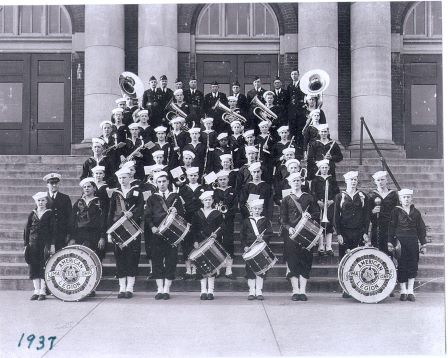
Farron U. Sims
1895-1978
Director of the American Legion Boys’ Military Band and the Alpha Marcus Choir, and was a music educator throughout his life.
Farron U. Sims
The Sims family has left a legacy in this community through music with a career that spanned over 50 years. Farron U. Sims was the director of the American Legion Boys’ Military Band and the Alpha Marcus Choir, and was a music educator throughout his life.
Farron U. Sims was trained on the violin and regularly gave performances at his church, South Side Christian Church at Central and Kibby Street. Sims directed the American Legion Boys’ Military Band from 1936 until the United States’ entrance into World War II in 1941. He also taught music classes with the Works Progress Administration (WPA) during the Great Depression. At its peak in 1936, the American Legion Boys’ Military Band, which he directed, had over 70 members and often delivered performances to more than 700 people. Their performances were all over the community, and they played large concerts twice a year. They were given uniforms that were regular sailor outfits that were described as consisting of “… blue blouses and pants, white leggens, and white sailor caps.” Glenn Custer was added to the band in 1937 to help during their busy time of traveling during the summer.
The Alpha Marcus Choir was started in 1939, and it consisted of 16 young black men. They sang at meetings and churches across the community.
Following Sims’s retirement, he continued to teach classes before his death in 1978. Sims’ son, Bruce, remained in the music industry, and he was also a part of the band in 1937. Bruce’s career was owning and operating Lima Instrument Repair.

Easter Straker
1918-1992
Broadcaster in both radio and television, and community charity organizer
Easter Straker
Easter Straker, who is among the most recognizable voices and faces of the community in the 20th century, had a career that spanned over 50 years. Her community work and television programs made her an iconic figure in Allen County. Easter was born on August 25, 1918 to John R. and Madge Straker. Straker earned her bachelor’s and master’s degrees from Indiana State Teachers College. However, she chose a career in broadcasting. Straker’s programming at WIMA, now WLIO, put on shows such as “Easter’s Parade.” Her show covered a variety of topics, including testimonials from herself. Easter’s radio program was heard each morning at 10 a.m., and it was an informal chat about anything from basketball games to flower shows and more. One of the most recognizable aspects of her show was the “birthday chair” segment. She interviewed and gifted children toys and, later, pennies from 1955 to 1984. She interviewed more than 41,600 children in this program, and one of the birthday chairs currently sits in the museum. Straker gave talks to area organizations on her global travels and more, including one that was titled “Living in the Space Age” in 1963. Straker organized a drive for the Allen County Polio Fund in 1954, and she raised over a million pennies. Easter promoted the Teddy Bear Fund, which continues to deliver teddy bears to sick children in Lima area hospitals today. She also donated time and money to Marimor Schools throughout her life. She retired in 1991 and passed away after a seven-year battle with colon cancer in 1992.

Dollie Taylor
1922-2020
Active in civic work in area churches and county organizations, and Head Start teacher
Dollie Taylor
The energetic Dollie Taylor was known for wearing multiple hats in her style and civic work. Taylor became the first Black president of Church Women United in 1969, where she had served as secretary two years prior. During that time, Church Women United added a new addition to the Mizpah Community Center (now the Cheryl Allen South Side Center). Lima La Sertoma Club named her Woman of the Year (1996) for her work as president of the Riverside North Neighborhood Association, which she helped found. During her tenure, the association provided equipment for the Lima Police Department’s Riverside North community outpost, coordinated neighborhood cleanups including in Faurot Park, and hosted activities for Make A Difference Day. In addition to participating in plays and singing at the Second Baptist Church, Taylor served as Missionary Society president, Ladies Aid Society president, Children’s Division of Sunday School superintendent, choir director, and chaired events and campaigns. Taylor also instructed Head Start at Southside Christian Church. She held several positions at the Lima-Allen County Head Start program between 1969 and 1987: teacher, workshop director, and volunteer and parent coordinator. At the Bradfield Community Center, Taylor taught preschoolers, advised senior citizens, and worked on several committees. She served on the YWCA and Mizpah Community Center boards. Taylor participated in the Democratic Minority Caucus, Church People for Change and Reconciliation, Forsythia Garden Club, and Aealeon Club. She moderated focus groups on the community health assessment, Healthy People 2000. Throughout her volunteer work, Taylor gave presentations on a variety of topics to local groups. She earned an associate’s degree in child development from Lima Technical College in 1977. Dollie and her husband, Raymond, married in 1941 and had one daughter. Taylor died in 2020 at 98 years old.
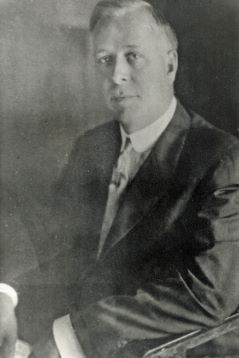
A.L. White
1861-1925
President of Lima Locomotive Works
A.L. White
The genius behind Lima Locomotive Works and a variety of other industries in Lima is Arthur Lincoln White, otherwise known as A.L. White. In 1861, he was born in Knox County, Ohio. A.L. White married Lucy Belle Spindler in 1900, and together they had one daughter named Janet.
White began his career at the shop of the C & G company, which was the manufacturer of the “Corliss” engines. He remained with this firm for 25 years. He began the job at the age of 15 as an office worker and eventually worked his way up the company ladder to become the superintendent of the plant. In 1900, Ira Carnes of the Lima Locomotive and Machine Company, which manufactured shay engines at the East Market Street plant, offered A.L. White a job. He met with the board and was offered the general manager position with a monthly salary of $200.
The following year, he was elected president of the company. The position had several ups and downs. In 1902, White spearheaded the expansion of new shops for work on the south side of Lima. The following month, the Lima Locomotive Works sold Woodlawn Cemetery 20 acres of land to the east of the cemetery. The company also secured 206 acres of city land to divide into lots, which were subsequently sold with proceeds intended to create a new plant on South Main Street. From the plots of land, LLW also donated a substantial section of land for a public park, which was later named Faurot Park.
By 1903, the company was the largest it had ever been; 600 people were employed, making it one of the largest in the United States. From 1903–1905, strikes happened by workers who demanded an end to piecework and unfair replacement by non-union men. The company in the end agreed to workers’ demands, and the 1905 strike caused a raise in the workers’ wages, which were declared to “be paying the best wages of any shop in this city.”
He was also integral to the organization of Ohio Steel Works and was the brains behind bringing the Logan-Gramm Truck Co., later named Gramm-Bernstein Truck Co., to Lima from Bowling Green, Ohio. The Gramm-Bernstein Company later produced the Liberty trucks used during World War I. He would leave Lima Locomotive Works as president in 1916. Following a series of failed business ventures, including a candy factory, a foundry, and a vacuum machine cleaning company, White would die in 1925 in their home at 711 W. Market Street

Christopher Stark Wood
1772-1855
Founding Father of Allen County
Christopher Stark Wood
Christopher Stark Wood, founding father of Allen County, arrived in this area around 1824. He assisted in organizing Sugar Creek, Hog Creek, and Wapakoneta settlements. He served as Justice of the Peace in Amanda and Bath Townships. Between 1829 and 1831, his efforts focused on establishing Bath Township and the county seat. Wood was the first clerk, a treasurer, then a supervisor of the Commissioners of Bath Township. He oversaw the surveying and platting of 160 acres for Lima, the county seat. As Lima’s first and only Town Director, he superintended the first public sale of lots. However, a corrected copy of the Deed of Lima was filed with the state in 1844 due to errors in the description of the land. Wood also served as an Associate Judge for the Court of Common Pleas and as Road Commissioner to engineer a State Road from the Loramies to Wood County via Wapakoneta and to survey a road through, Bellefontaine, Lima, Putnam County, and Defiance. His home was a place of worship for different denominations, the first Sunday School in Allen County, and a store. He taught Sunday School and arithmetic.
Born in the Virginia Counties (Pennsylvania today), Christopher Stark Wood spent his teenage years in Kentucky. Eighteen-year-old Wood joined the militia, where he fought against American Indians to increase the United States’ Northwest Territory in Ohio. He accompanied the expeditions of George Rogers Clark and Benjamin Hogan; participated in the border invasions by General Harmar (1790), General Arthur St. Clair (1791), and General Anthony Wayne (1794); fought in the Battle of Fort Recovery; and scouted during the Battle of Fallen Timbers. Wood participated in the burning of Shawnee villages under General Benjamin Logan in what would become Champaign and Logan Counties, including Blue Jacket’s Town (Bellefontaine today). During War of 1812, Wood fought at Frenchtown in 1813, witnessing the River Basin Massacre, and at Fort Meigs. In 1812-1813, Wood became the captain of a spy company, participating in Tupper’s March from Urbana to Fort Meigs, and he later recruited and trained spies in the 26th regiment of the U.S. Infantry at Urbana.
Wood married Mary Ann Turner on October 6, 1797, and they had ten children. The Woods moved to Ohio in 1799, living in the Bush Creek settlement in Warren County. By 1805 the Woods moved to Champaign County, Ohio, where Wood was Miami Township’s Justice of the Peace, and to Logan County, where he helped establish Bellefontaine in 1820. While visiting his son in Athens, Indiana, Wood died due to injuries from a train wreck in 1855 and was buried there.
This exhibition is made possible in part by Ohio Humanities, a state affiliate of the National Endowment for the Humanities. Any views, findings, conclusions, or recommendations expressed in this exhibition do not necessarily reflect those of the National Endowment for the Humanities.













